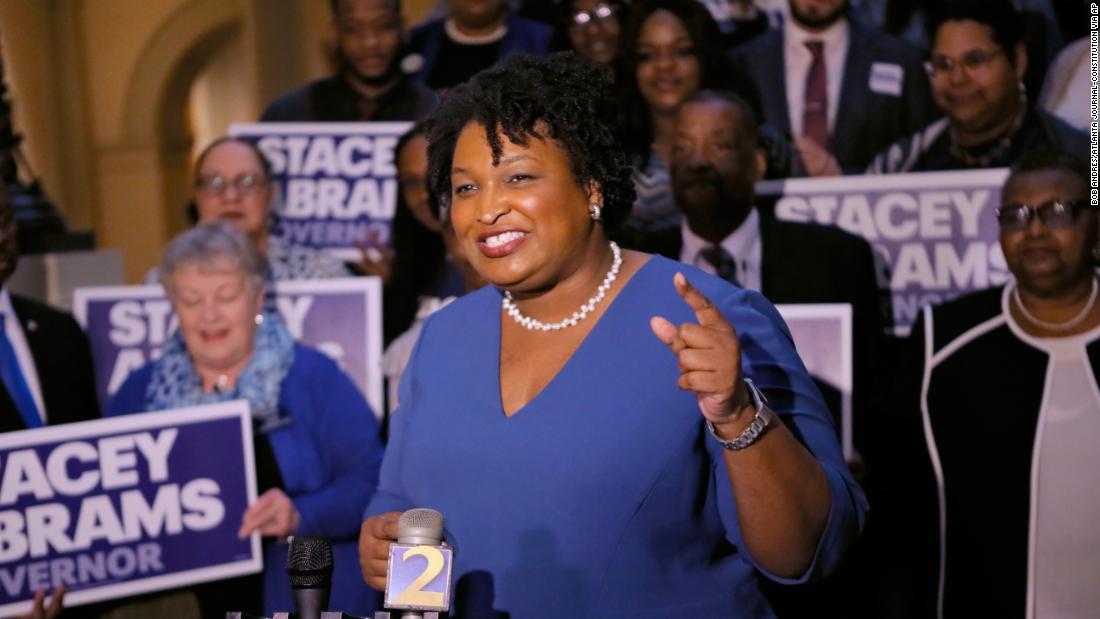[ad_1]
A young Stacey Abrams had traveled with her parents on a city bus to the Georgia Governor’s Mansion so she could be honored along with the state’s other top students.
It was a moment of immense pride for Abrams, the Avondale High School valedictorian, and for her parents, too, who had prioritized education for themselves and their six children despite their own poverty.
But as the African-American family approached the tall black gates that day in 1991, they were stopped by the security guard.
“I distinctly remember him looking at the MARTA bus, looking at my parents and making a decision. The security guard refused to allow us inside. He said it was a private event,” Abrams recalls.
That situation was resolved with a check of the guest list — “Abrams” was the very first name — but it left its mark on the teenager. Abrams still doesn’t know if it was her race that caused disquiet, that she’d arrived on public transport or a mixture of the two. But she knows it fueled her drive, a drive that has now pushed her to be a leading Democratic candidate for Georgia governor.
“In front of the most powerful place in Georgia, telling me I don’t belong there, that’s resonated for me for the last 20 years. The reality is having a right to be places does not always mean that you’ll gain admission,” she says, with passion punctuating her words.
While women have not been literally shut out of governors’ mansions, 22 states have never had a female chief executive. They include states with massive populations like California, New York, Florida, Pennsylvania and Illinois.
But the rise of women in politics since the election of Donald Trump, which has seen record numbers standing for election, is impacting the highest offices in states, too.
In Georgia, Abrams is vying with Stacey Evans to win the Democratic primary on Tuesday to be the (female) candidate who hopes to turn Georgia blue in November.
The all-female primary has attracted national attention — for the women running, the fact that they share a first name, and the energy among Democrats who believe, again, this might be the year to seize one of the state’s centers of power.
Even though either woman would be the first female chief executive in Georgia’s history, they are emphasizing their differences ahead of the May 22 primary.
Evans also grew up in poverty and became the first member of her family to attend college, thanks to Georgia’s HOPE scholarship. Restoring the broad promise of the HOPE scholarship is now a central part of her campaign. She accuses Abrams during her time as House minority leader of making it harder for students to get funding by working with Republicans to bring in cuts.
Evans, a state representative, is targeting progressives and disillusioned Republicans and moderates in her campaign.
Abrams, who would be the first black female governor in the United States should she win the primary and then again in November, feels that strategy has already failed and would be a sure-fire loser for her in particular.
“I’m very aware that as an African-American woman, I will be doing something no one else has done,” said Abrams.
“We cannot win by pretending to be something we are not,” Abrams said. “My mission is to demonstrate that if we bring everyone to the table we can win.”
Abrams grew up in Gulfport, Mississippi, one of six children to parents who later attended Atlanta’s Emory University and became ministers. “School, church, family,” said Abrams of her upbringing. She shares stories about a working poor family, whose parents emphasized education yet struggled to pay their bills. Abrams wrote an article addressing her own $200,000 debt in credit cards, student loans and IRS tax payments, telling voters that it should not disqualify her from being governor.
But even as she promises to run “an authentic campaign that is grounded in who I am and what I’ve done” she knows she has to reach people who are different from her.
In two days, she went from an Atlanta-area black church to a north Atlanta-area Mexican restaurant. Her message was clear to both minority audiences: I’m one of you.
From there, she headed far out of the big-city Democratic bubble to Dahlonega, a small former gold-mining town in the foothills of the North Georgia mountains and deep in Georgia’s Trump country.
The overwhelmingly white crowd chanted “Stacey, Stacey, Stacey.” People lined up to take selfies. One woman, moved to tears, embraced Abrams.
Just yards away, pickup trucks, including one flying a “Don’t Tread on Me” flag, circled the town square in what appeared to be a display of conservative feelings, but Abrams was not fazed.
“We’re in Trump country. I’ve got to win Georgia. I’ve got to turn out more Democrats everywhere. And this,” said Abrams, referring to her supporters, “is proof that there are Democrats even in Trump country.”
On Tuesday, Stacey Abrams and Stacey Evans will find out which campaign hit on the right strategy in their Democratic primary. Both are on the path to challenge state history in the general election. One may set a new national standard in the unlikeliest of American states.
[ad_2]
Source link







